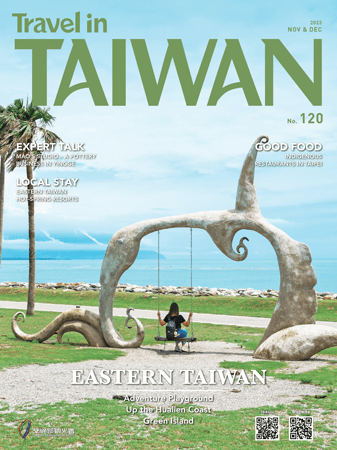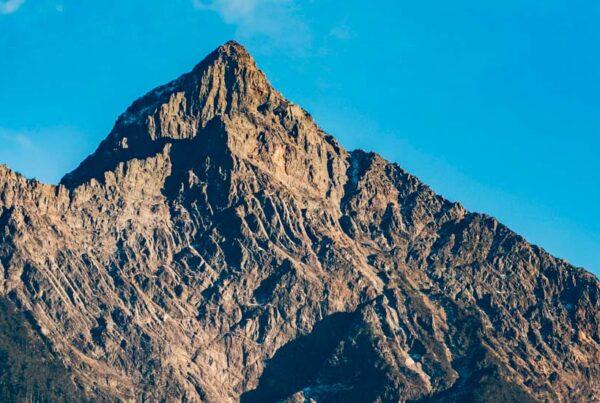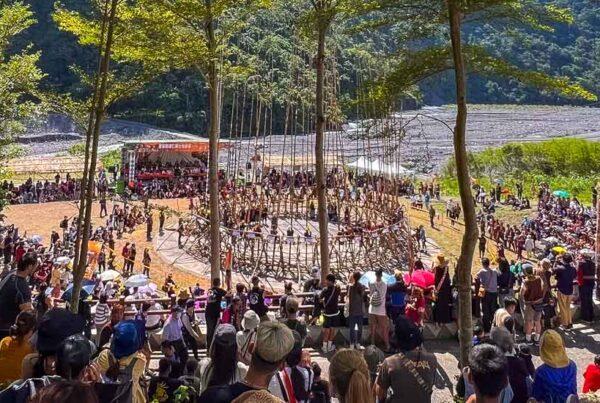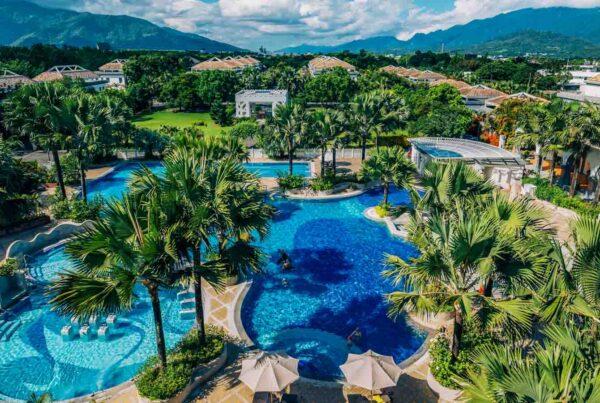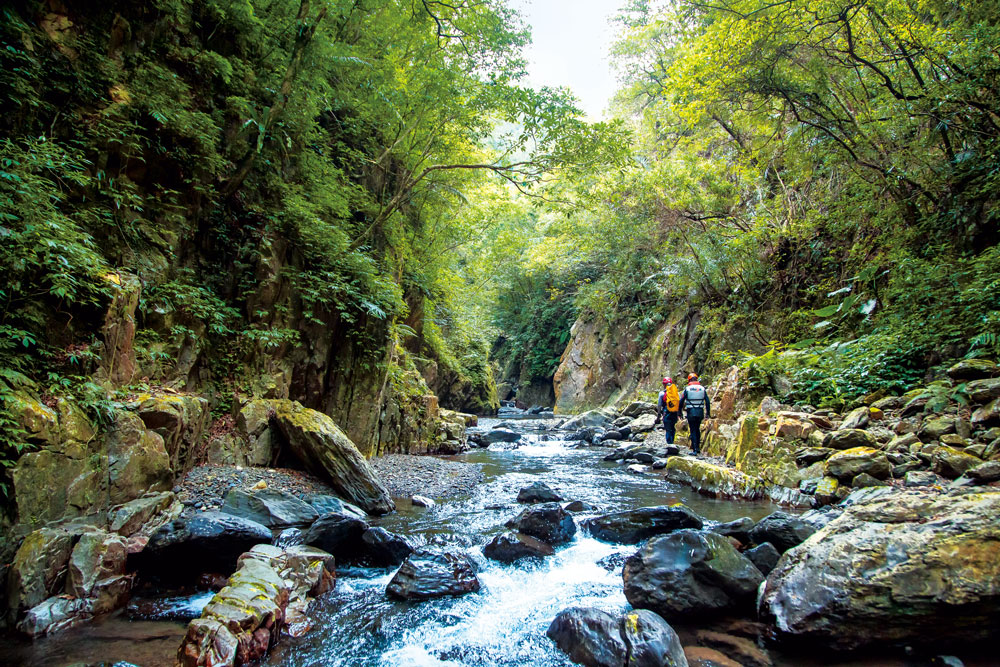
River tracing along Dezikou River in Jiaoxi Township
A subtropical/tropical mountainous island with abundant rainfall, Taiwan is a wonderful playground for outdoors enthusiasts. One of the best ways to spend time in the embraces of Mother Nature here is following a mountain stream uphill, preferably with a magnificent secluded waterfall waiting for you as highlight of your adventure outing. Earlier this year we went river tracing in Jiaoxi, a great location for experiencing river-tracing the first time.
Text: Richard Saunders; Photos: Chen Cheng-kuo
That first step into the stream, as the ice-cold water seeps into our neoprene boots and sends chills coursing upwards through our bodies, is the hardest part. As we wade deeper, towards the center of the watercourse, and begin to plot a way upstream between the rocks and white-water cascades, we begin to warm up as our minds turn from the cold to the adventure ahead. We’re river tracing up the Dezikou Stream in Yilan County, and although Taiwan in early March isn’t high season for this increasingly popular outdoor activity, after a few minutes we’ve adapted to the cool air and water and are enjoying our river exploration.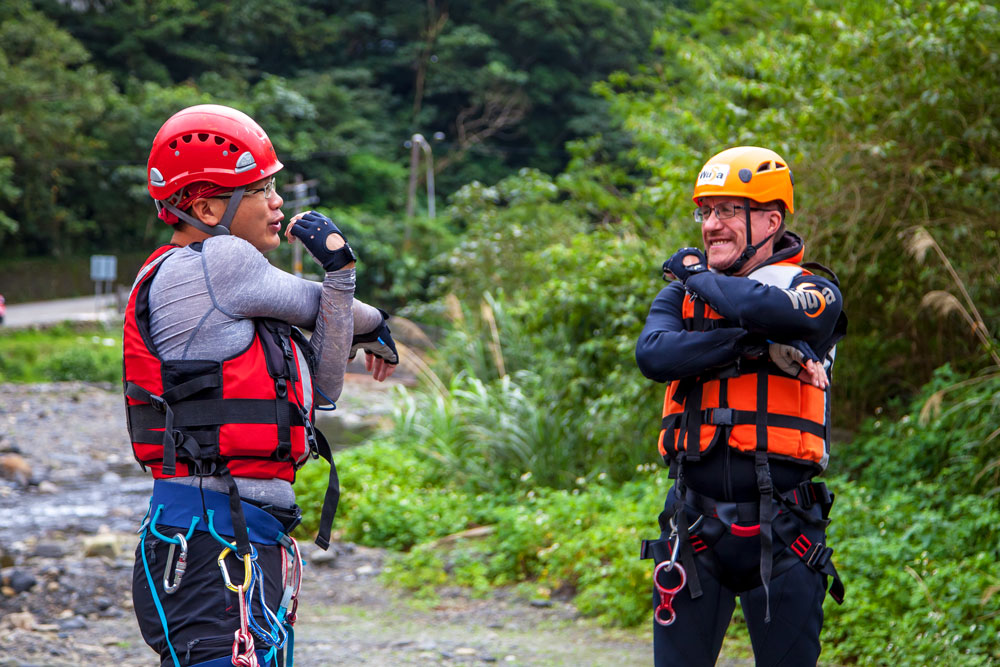
A little warm-up before the river trace
Canyoning, river tracing, kloofing (derived from Afrikaans), suoxi (Mandarin Chinese) – no matter what it’s called, tracing a mountain stream is one of the very best ways to see Taiwan’s mountainous interior at its finest. It’s been a popular activity here for quite some time now, and for outdoorsy sorts, it’s a prime way to spend a hot summer day.
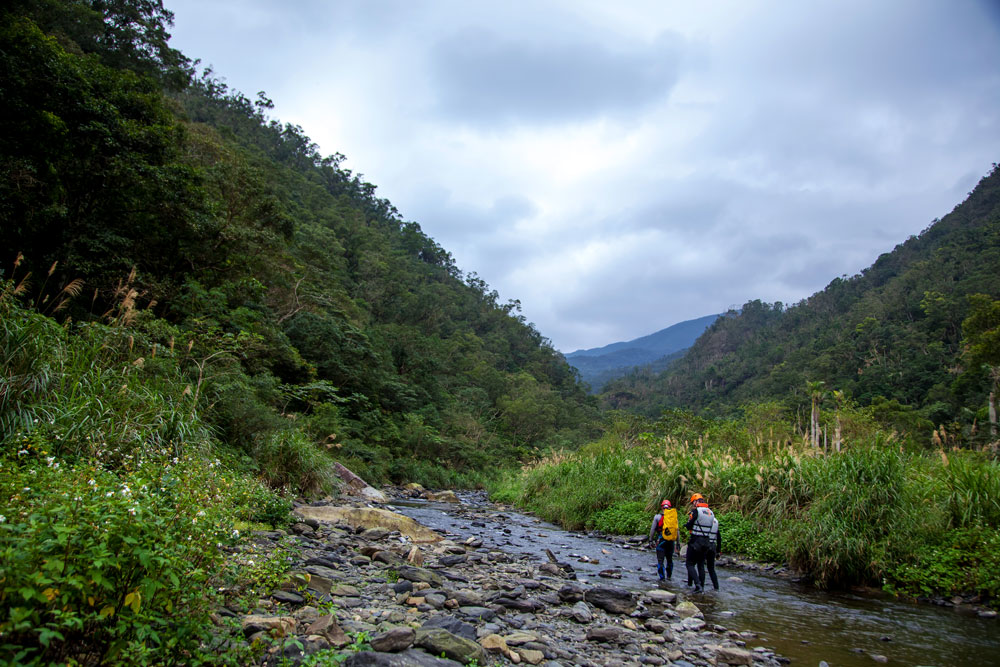
The river is flat and shallow in the beginning
Standing in the car park beside the Dezikou Stream in Yilan’s Jiaoxi Township before beginning our trace, we meet our guide, Wusa Lin, who explains the basics and hands out our gear for the day, which we put on. The most essential item is a pair of river-tracing boots; the felt-covered soles of these boots help prevent slipping on algae-covered rocks. Then there’s a waterproof bag (for clothes, camera, etc.) and a helmet to protect the head in the event of a slip or rocks falling down from above. We’re also given a wetsuit (in early March, the northern Taiwan winter is only just beginning to let go). A safety harness and buoyancy aid round out the river tracer’s essential equipment. Waterproof sunscreen is compulsory too, at least during the summer. Even deep in a wooded gorge, the midday sun can be very powerful! Wusa gives a quick rundown of conditions in the stream we’re about to enter, and we’re off!
Taiwan is a very mountainous country and affords not only fantastic hiking and trekking but also literally hundreds of scenically stunning waterways suitable for river tracing. However, the incredibly varied terrain, coupled with the remoteness of much of the interior, means that many river-tracing trips either must be multi-day camping expeditions or have serious obstacles, such as challenging waterfalls, which makes them strictly for the highly experienced and well-equipped.
Nonetheless, there are also many easier, one-day river traces around the island, suitable for beginners or those with just a little experience. Two of Taiwan’s classic easy-grade river traces, Lupi Creek and Golden Grotto, are on the east coast of the island in southern Yilan County and northern Hualien County, respectively.
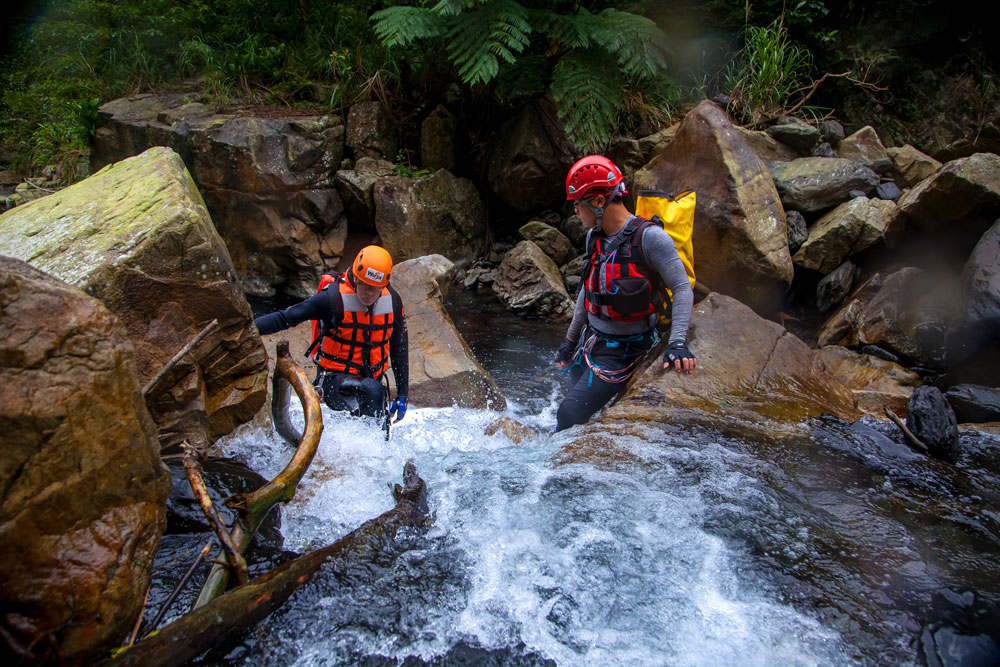
Then you have to make your way across small waterfalls
The trace up Lupi Creek, near the port town of Nan’ao in Yilan County, culminates at a magnificent waterfall, while at the beginning of the trace an eight-meter-high cascade doubles as one of Taiwan’s most hair-raising natural waterslides. Arrive on a busy weekend and there’s a good chance you’ll see river-tracing daredevils launch themselves off the brink and slide over the waterfall into the deep water below. Several outdoor-activity companies are based in Nan’ao, a few kilometers from Lupi Creek, and can organize trips not only there but also to several other excellent river-trace locations in the area.
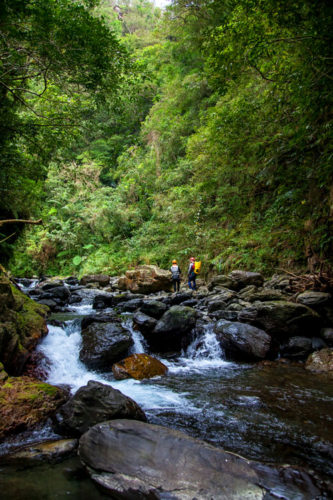
Natural river and natural forest, a perfect combination
Just a short drive south of the oceanside entrance to the fabulous Taroko Gorge, the Golden Grotto is probably Taiwan’s most revered one-day trace. This deep, stream-cut slot canyon is carved into the marble above the little Truku tribe village of Sanzhan, and to get there means climbing up three cascades, each taller than the last. Between each waterfall is a deep pool of deep blue-green water, which tracers must swim across. At the top of the canyon, the stream leaps over a tall and spectacular waterfall into the largest and most beautiful pool of all.
Although the Golden Grotto is suitable for those with only a little river-tracing experience, a guide is essential, both to ensure safety and to put ropes up on each of the waterfalls. The Hualien area is also riddled with other beautiful river-tracing routes, and safe, guided trips to many of these (and to the Golden Grotto as well) can be organized by Hualien Outdoors, run by a knowledgeable expat from Canada with years of experience who offers tracing excursions to many of the beautiful streams in Hualien.
Down in the south of Taiwan, another famous easy trace is Haishengong (“Sea God’s Palace”) in Pingtung County’s Sandimen District. The Sea God’s Palace itself is formed by two deep, rounded, cliff-bound pools at the lower end of the gorge. Above it, a series of deep, interconnected pools culminates in a pair of small waterfalls, between which lies the largest plunge pool of all, called Dai’ena Sacred Pool. The curious names of the pools in the gorge come from a Paiwan tribe legend, which attributes their formation to the legendary antics of their Sea God.
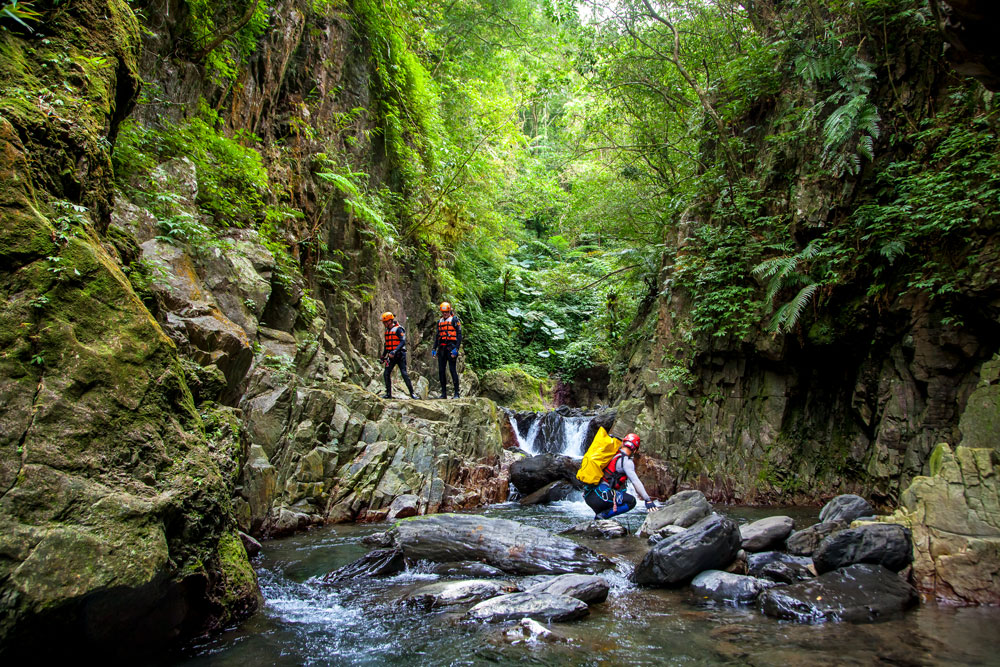
This is a particular pretty spot in the gorge
Our river trace today is a great beginner’s route. Not only is it easier than the classic traces described above, it’s also only just over an hour’s drive from Taipei, and it’s very scenic too. After entering the water just above a large weir, we start gingerly making our way upstream, feeling our way and trying to avoid loose or algae-covered rocks. After ten minutes or so we’ve already started to grow accustomed to where (and where not!) to put our feet, and we start to look up more to enjoy our increasingly scenic surroundings as we enter a very beautiful rocky gorge. In a few places the going then gets slightly more challenging, with a few short scrambles up rocks beside little cascades, but we all make it up with the help of Wusa, our ever-vigilant guide. Our sense of accomplishment continues to grow as we proceed further and further upstream.
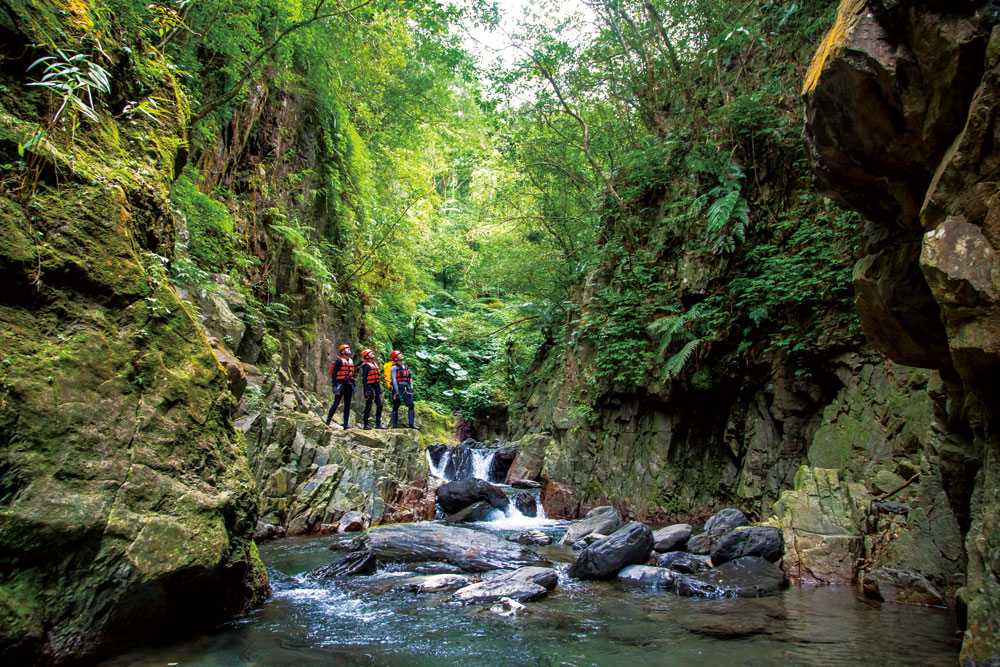
There was nothing particularly interesting to look up there…
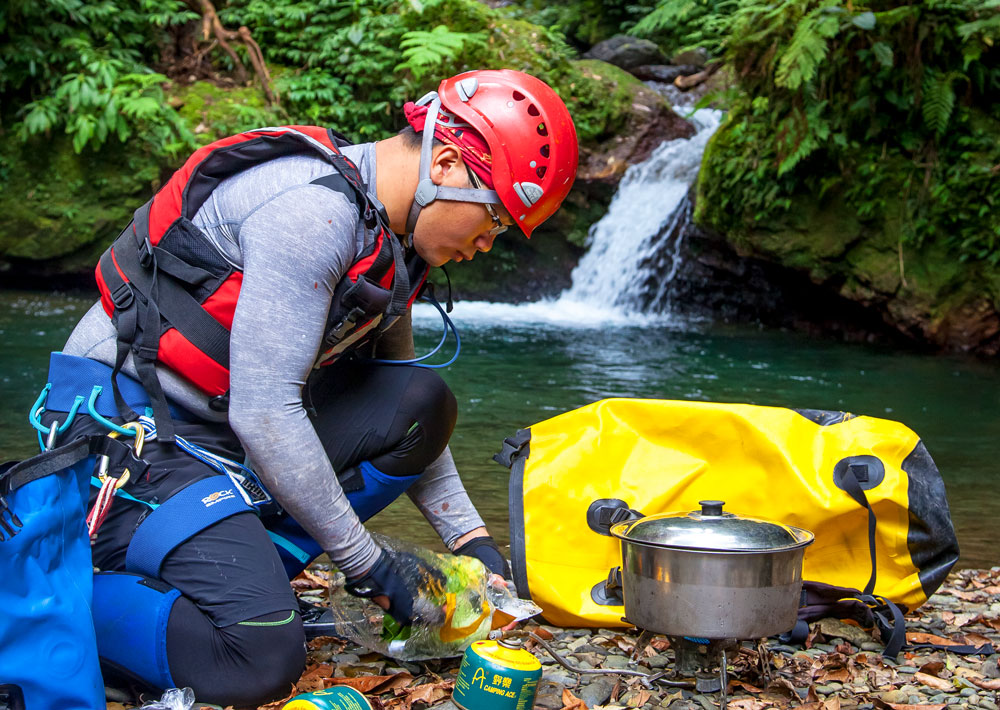
Preparing a simple lunch at the river
If you’re new to river tracing in Taiwan, be sure to engage the services of a qualified guide, who will supply the correct equipment, choose a route suitable for your group, ensure safety, and obtain insurance and any necessary permits. Most beginners join an organized tour, for which equipment such as footwear, life vest, ropes, wetsuit, and other extras are all provided.
Summer is naturally the perfect time to try your first river trace, offering the perfect retreat from the intense heat. Nevertheless, at lower altitudes and in the south, winter isn’t such a bad time to try it either. While at higher altitudes waterways are icy-cold year-round, the water in streams closer to sea level never really gets too cold, even during the winter months.
Whatever time of year you go, choose a dry, settled day, and definitely don’t head out on any adventures for a couple of days after heavy rainfall. During summer, afternoon thunderstorms can cause dangerous flash floods in certain areas, so groups usually get an early start, and a responsible and professional leader will keep an eye on the weather situation and be aware of escape routes at all times.
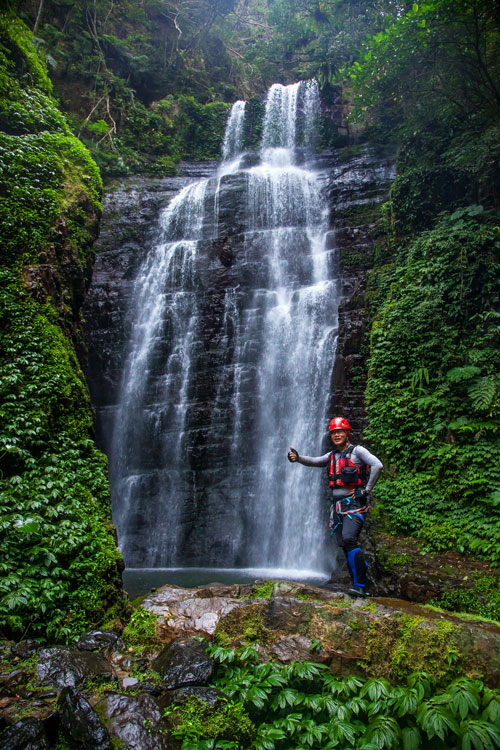
Yuemeikeng Waterfall, the end point and highlight of the river trace
After nearly three hours clambering up the stream, stopping every few meters to snap a photo of the enchanting, ever-changing rock-and-waterscape around us, we reach the mouth of a slot-like canyon. After cooking up a much-needed hot lunch on a small sandy spot beside the stream, our guide takes us further up, into the mysterious gorge. We clamber up some rocks off the left side of the tumbling stream, and finally come face-to-face with Yuemeikeng Waterfall, the stunning climax of the day’s adventure.
Here the stream plunges over a 40-meter-high cliff in a wide veil, falling into a very large pool. It looks a little like the uppermost of the three much-easier-to-visit Wufengqi Waterfalls, which are in the same watershed area – but unlike at that famous tourist attraction, apart from the four people in our little group there’s not a soul about at Yuemeikeng.
Since there’s no way to build a trail or path through the narrow cleft below it, the waterfall can only be reached by walking up the streambed. That, perhaps, is the greatest attraction of river tracing: it’s the sole means of getting to some of Taiwan’s most breathtaking, pristine places, and if you visit, you’re more than likely to have these places all to yourself!
Info
Our river trace was organized by Wusa Lin of Eco-Explore, a local outfit which arranges river-tracing excursions for both beginners and those with river-tracing experience, at locations all around Taiwan.
For trips in the Hualien area, contacting Matt Hopkins of Hualien Outdoors is highly recommended.
You don’t need to do river tracing to visit these impressive falls:
Also in the area is the trail to Shengmu Peak. Great scenery up there!
taiwaneverything.cc/2016/11/29/hiking-shengmu-peak-near-jiaoxi/
Guan Xiang Century Resort Hotel (冠翔世紀溫泉會館) No. of Rooms: 80 Add: No. 6, Ln. 66, Ren’ai Rd., Jiaoxi Township, Yilan County City (宜蘭縣礁溪鄉仁愛路66巷6號) Tel: (03) 987-5599 Website: www.hotspring-hotel.com.tw 








